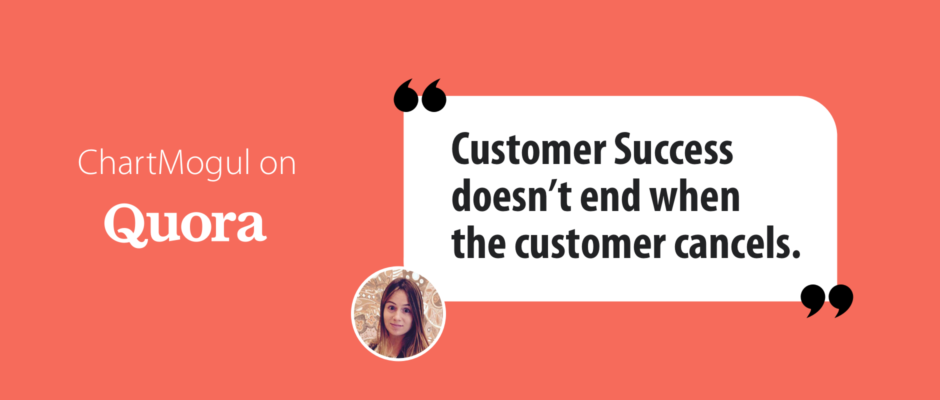In SaaS, most focus is placed on preventing churn, and for good reason.
But it’s hard to find solid advice on what to do after a customer churns — how to manage a relationship post-cancellation, and how to (ideally) nurture the customer back to reactivation.
Why is reactivation important?
Studies show that re-engaging inactive users is 5 times more cost-effective than acquiring new ones. This relates to cancelled subscribers in that you’ve already invested the costs of acquiring them, you know a bit about their behavior, and hopefully — you already know what you can do to bring them back on board and keep them happy.
That said, investing in Reactivation MRR isn’t for every business nor every customer. Having a strategy to nurture cancelled customers is more important for seasonal business, for instance.
When is reactivation not important?
No need to chase down accounts of low LTV, who yield low MRR, or who aren’t your target customer. But I’m guessing everyone has at least a couple high-value cancellations they would love to get back.
Post-churn feedback: Make a good last impression
Record feedback on WHY the customer cancelled. You can do this through an automated survey upon cancellation, an automated templated email, or a personalized email. You learn where you can improve — limitations in the product itself, insufficient training or education in how to use the product, poor customer support, etc.
You also show the customer that you care about their experience, even if you’ve already lost their business. Here is where you make a good last impression. Thoughtful follow-up like this sets the foundation for positive sentiments and revived interest down the line.
At ChartMogul, we ask our customers why they’ve cancelled. Then we focus on classifying and addressing those issues moving forward. What else can you do with the feedback you received? Design what Niko Moraitakis of Workable calls a “second order marketing machine” — wherein you try to stay top-of-mind for former customers.
“What you would like to do is to capture [reasons for cancelling], to understand who are the people in that category, and market to them specifically in different ways.” – Nikos Moraitakis
Post-churn email marketing: Throw out a line
Once you’ve segmented the cancelled customer base to define which accounts are worth pursuing for reactivation, you can move forward with marketing to them. There are a few tactics to keep these churned customers warm to your brand or your product, without spamming or annoying them.
The standard (and low cost) tactic is to send informative emails:
- Announcing product / feature releases. This is key, as any improvements could be the very fix the customer needed to see to get more value from your product. You can make these even more strategic by matching up a product release with a list of customers who cancelled because of the lack of that feature. (You could track cancellation reason in your CRM of choice, tag it as an account attribute in your analytics tool, etc, and then segment your customers by cancellation reason.)
- Offering major original content. Send emails announcing content that could serve as a resource for them, such as an eBook, whitepage or webinar. Customer education — and customer success — doesn’t have to end when the customer cancels. If you can show you’re still a source of advice and a thought leader in the industry, then you continue to build your brand and your ex-customer’s trust.
- Your regular newsletter. This is really just a passive, routine reminder about your existence. A newsletter would likely include the two items listed above.
Post-churn incentives: Throw out a bone
This strategy is proactive and pretty overt. You want to bring them back on board and are willing to work for it.
Note: There are pros and cons to offering any element of free service. It doesn’t suit all products or business types, and of course you don’t want to run the risk of devaluing what you offer.
- Another free trial with customized / live demo. Perhaps the customer cancelled simply because they didn’t fully understand how to use your product, a failure of customer success. This approach shows special care to their specific needs and objectives.
- A one-time discount or special rate for reactivation. If you offer a lowered rate, you probably want to make this a contract with a monthly minimum, so you ensure you earn back that MRR through LTV.
- Free service until a feature is added or improvement made that solves their pain point. Example: A customer tells you they absolutely can’t receive value from your product until feature X. This customer is high value, or has great potential to be, and feature X is in your pipeline anyway. So it could be worth it to just hold them on for free until you release what they need.
Are your reactivation efforts successful?
Typically, SaaS companies and subscription services measure their reactivation MRR as a standard metric of business performance. It’s one of the five MRR movements we track in ChartMogul. But in this context, reactivation is tracked as a portion of all company MRR, an absolute number — and it’s not a full picture of whether your “second order marketing machine” is becoming more effective.
To properly measure your reactivation efforts, you should measure reactivation as a rate: The percentage of your churned customers that reactivate. You can measure reactivation much like you measure initial trial-to-lead conversion: How well are these strategies bringing people back on board?
To learn more about the five MRR movements and other subscription metrics, check out the Ultimate SaaS Metrics Cheat Sheet.
If you want to learn more about more proactive strategies you can take — before customers cancel — read on about steps you can take to predict and prevent churn in the first place.
